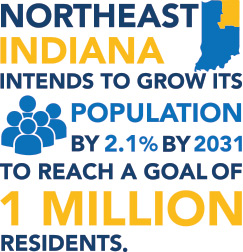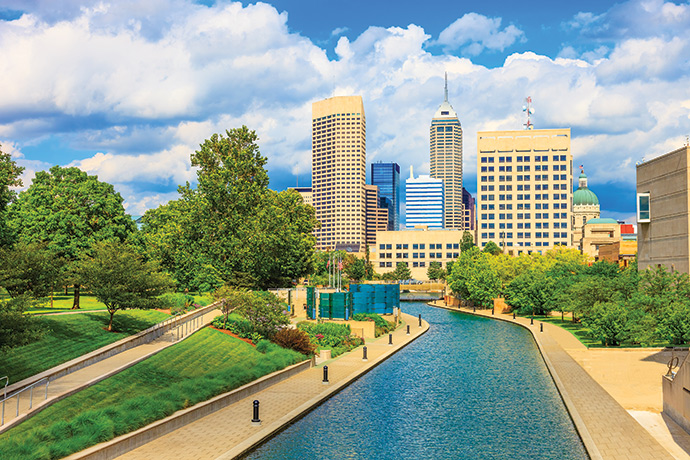Indiana’s Regional Cities Initiative is prompting city and regional planners, elected officials and business leaders to imagine a future of vibrant, youthful urban centers and to take bold steps to make that vision a reality. The program, launched in 2016, is aimed at boosting quality of life across the state, and thus attracting and retaining young talent to help make cities blossom and propel the statewide economy. It’s having a big impact already.
Conceived by former Governor, now Vice President Mike Pence, and supported by his successor Eric Holcomb, the Regional Cities Initiative (RCI) has spread investments in the tens of millions of dollars across seven designated regions that responded to the call to formulate detailed and innovative plans to enhance the livability of urban areas. Under the Regional Cities Initiative, unused buildings are being refurbished as venues of learning, business and entertainment; city streets are being beautified; walkways, bicycle paths and greenspaces are flowering; transportation networks are being rethought for greater flexibility and environmental efficiency; technology hubs are springing up; institutions of higher learning are expanding with the goal of attracting and nurturing the workforce of tomorrow. The state’s collective imagination is embracing the clarion call.
“This program,” said Governor Holcomb recently, “is transforming cities and towns and bringing officials across political party and geographic boundaries like never before. By capitalizing on our past to transform our present, the Regional Cities Initiative is not just a key component of today, it’s a vital piece to realizing our state’s future in taking Indiana to the next level.”
State officials say it’s a mission born of demographic necessity. Holcomb maintains that in the next 10 years, Indiana employers will need to find a million skilled workers to replace 700,000 retiring baby boomers and to fill an expected 300,000 new jobs.
“Too many Hoosier businesses,” says Governor Holcomb, “are having trouble finding the skilled workers they need to grow.” Building out fresh-faced urban centers is viewed as crucial to luring a new generation of technologically savvy go-getters, and to halting the flow of native Hoosiers who might otherwise relocate elsewhere.
“Indiana as a state has a very high level of educating young people,” says South Bend Mayor Pete Buttigieg, “but a very low level of keeping them. This is about changing that equation.”
Attracting Entrepreneurs
Alex Sejdinaj is precisely the sort of youthful entrepreneur Indiana sees as its future. Sendinaj, 28, a graduate of Indiana University, is founder of the South Bend Code School, which provides training and web development skills to South Bend high schoolers interested in technology careers. Sejdinaj moved back to his hometown after living in Nashville, where he worked in the music tech industry.
“We’ve got over 20 tech startups in the area. We’ve got a lot of industry that’s already established that needs tech workers. We’re really primed as a region to become a tech powerhouse. People are starting to realize a lot of cool stuff could happen here.”
“Our goal,” says Sejdinaj, “is to make South Bend a city that codes. We just need more people who have the knowledge and the skills and understand that they can do these things. We’re attracting a lot of young people to the region.”
Sejdinaj’s school is a prime beneficiary of one of the marquee projects under the Regional Cities Initiative, the restoration and redevelopment of the former Studebaker factory in South Bend, which was built in the mid-1800’s and covers an imposing 1.1 million square feet on 30 acres. The $11 million project is being shouldered by $4 million in private investment, $3.5 million in Regional Cities funding, and $3.5 million from other public sources. It is envisioned as the biggest technology hub of its kind in the Midwest. The renovation still has several years to unfold, but the South Bend Code School has moved into an area of the complex that’s already completed.
“We’ve got kids who are learning a skill set they can see as viable for them,” says Sejdinaj. “They see some of the tech companies in this area as places they could work for some day, and so they can look at South Bend as a place they don’t have to leave to do something cool.”
Building Out the Cities
Indiana’s North Central region, with South Bend as its hub, is one of three multi-county economies to receive full state funding of $42 million for RCI projects. The other areas selected to receive the top amount are the Southwest region, comprising three counties surrounding Evansville, and the Northeast region of 11 counties anchored by Fort Wayne.
The three winning regions offered plans for a total of 100 projects with a combined price tag of more than $2 billion. Proposed projects are being weighed individually for funding by the Indiana Economic Development Corporation (IEDC), which has also distributed $150,000 in planning grants to the four regions not selected in the initial funding phase.

Northeast Indiana, one of three big winners, has set a goal of growing its population by 2.1 percent by 2031 to reach a goal of one million residents. The region’s key proposed infrastructure projects include a riverfront development in downtown Fort Wayne, a regional trails network, youth development programs and downtown housing. In October, 2016, Fort Wayne broke ground on Skyline Tower, a 12-story retail and residential development funded through the RCI. Upon completion, it’s to feature 124 apartments and 170,000 sq.-ft. of retail and office space. Ruth’s Chris Steakhouse is to anchor the ground floor.
“Skyline Tower is a tremendous addition to the heart of our city,” says Fort Wayne Mayor Tom Henry. “I continue to be encouraged by the progress we’re seeing throughout Fort Wayne. We’re strengthening our position as a point of destination where individuals, families and businesses want to invest.”
In the Southwest Region, the state has approved Regional Cities funding to support seven projects, including housing and mixed use developments at Oakland City University and a new regional medical center in Poseyville.
“Both the Oakland University Boulevard Commons and the Regional Medical Center,” says Beth McFadin Higgins, president of the Southwest Indiana Regional Development Authority, “perfectly align with the goals of Indiana’s Great Southwest plan for attracting and retaining talent while building a better quality of place.”
As of late March, IEDC had approved a total of $52 million in Regional Cities funding, spread nearly equally across the North Central, Northeast and Southwest regions. Total funding for the 26 projects approved so far, including private and additional public expenditures, was $658 million.

